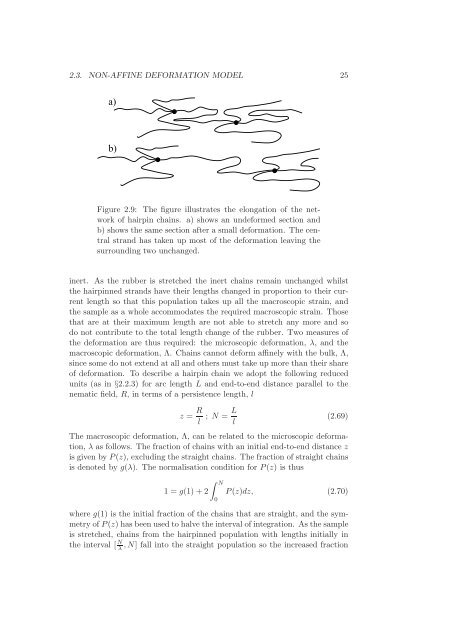Statistical models of elasticity in main chain and smectic liquid ...
Statistical models of elasticity in main chain and smectic liquid ...
Statistical models of elasticity in main chain and smectic liquid ...
Create successful ePaper yourself
Turn your PDF publications into a flip-book with our unique Google optimized e-Paper software.
2.3. NON-AFFINE DEFORMATION MODEL 25a)01010101b)01010101Figure 2.9: The figure illustrates the elongation <strong>of</strong> the network<strong>of</strong> hairp<strong>in</strong> cha<strong>in</strong>s. a) shows an undeformed section <strong>and</strong>b) shows the same section after a small deformation. The centralstr<strong>and</strong> has taken up most <strong>of</strong> the deformation leav<strong>in</strong>g thesurround<strong>in</strong>g two unchanged.<strong>in</strong>ert. As the rubber is stretched the <strong>in</strong>ert cha<strong>in</strong>s rema<strong>in</strong> unchanged whilstthe hairp<strong>in</strong>ned str<strong>and</strong>s have their lengths changed <strong>in</strong> proportion to their currentlength so that this population takes up all the macroscopic stra<strong>in</strong>, <strong>and</strong>the sample as a whole accommodates the required macroscopic stra<strong>in</strong>. Thosethat are at their maximum length are not able to stretch any more <strong>and</strong> sodo not contribute to the total length change <strong>of</strong> the rubber. Two measures <strong>of</strong>the deformation are thus required: the microscopic deformation, λ, <strong>and</strong> themacroscopic deformation, Λ. Cha<strong>in</strong>s cannot deform aff<strong>in</strong>ely with the bulk, Λ,s<strong>in</strong>ce some do not extend at all <strong>and</strong> others must take up more than their share<strong>of</strong> deformation. To describe a hairp<strong>in</strong> cha<strong>in</strong> we adopt the follow<strong>in</strong>g reducedunits (as <strong>in</strong> §2.2.3) for arc length L <strong>and</strong> end-to-end distance parallel to thenematic field, R, <strong>in</strong> terms <strong>of</strong> a persistence length, lz = R l; N = L l(2.69)The macroscopic deformation, Λ, can be related to the microscopic deformation,λ as follows. The fraction <strong>of</strong> cha<strong>in</strong>s with an <strong>in</strong>itial end-to-end distance zis given by P(z), exclud<strong>in</strong>g the straight cha<strong>in</strong>s. The fraction <strong>of</strong> straight cha<strong>in</strong>sis denoted by g(λ). The normalisation condition for P(z) is thus∫ N1 = g(1)+2 P(z)dz, (2.70)0where g(1) is the <strong>in</strong>itial fraction <strong>of</strong> the cha<strong>in</strong>s that are straight, <strong>and</strong> the symmetry<strong>of</strong>P(z) hasbeenusedtohalve the<strong>in</strong>terval <strong>of</strong><strong>in</strong>tegration. Asthesampleis stretched, cha<strong>in</strong>s from the hairp<strong>in</strong>ned population with lengths <strong>in</strong>itially <strong>in</strong>the <strong>in</strong>terval [ N λ,N] fall <strong>in</strong>to the straight population so the <strong>in</strong>creased fraction
















